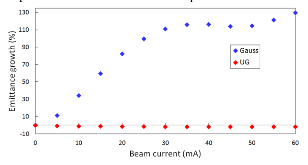Low emittance growth in a low energy beam transport line with un-neutralized section
Abstract
In a Low Energy Beam Transport line (LEBT), the emittance growth due to the beam's space charge is typically suppressed by way of neutralization from either electrons or ions, which originate from ionization of the background gas. In cases where the beam is chopped, the neutralization pattern usually changes throughout the beginning of the pulse, causing the Twiss parameters to differ significantly from their steady state values, which, in turn, may result in beam losses downstream. For a modest beam perveance, there is an alternative solution, in which the beam is kept un-neutralized in the portion of the LEBT that contains the chopper. The emittance can be nearly preserved if the transition to the un-neutralized section occurs where the beam exhibits low transverse tails. This report introduces the rationale for the proposed scheme and formulates the physical arguments for it as well as its limitations. In conclusion, an experimental realization of the scheme was carried out at Fermilab's PIP2IT where low beam emittance dilution was demonstrated for a 5 mA, 30 keV $$H^{-}$$ beam.
- Authors:
- Publication Date:
- Research Org.:
- Fermi National Accelerator Laboratory (FNAL), Batavia, IL (United States)
- Sponsoring Org.:
- USDOE Office of Science (SC), High Energy Physics (HEP)
- OSTI Identifier:
- 1419706
- Alternate Identifier(s):
- OSTI ID: 1415629
- Report Number(s):
- Fermilab-Pub-17-599-AD; arXiv:1805.01920; FERMILAB-PUB-17-599-AD
Journal ID: ISSN 2469-9888; PRABCJ; 020101
- Grant/Contract Number:
- AC02-07CH11359
- Resource Type:
- Published Article
- Journal Name:
- Physical Review Accelerators and Beams
- Additional Journal Information:
- Journal Name: Physical Review Accelerators and Beams Journal Volume: 21 Journal Issue: 2; Journal ID: ISSN 2469-9888
- Publisher:
- American Physical Society
- Country of Publication:
- United States
- Language:
- English
- Subject:
- 43 PARTICLE ACCELERATORS
Citation Formats
Prost, L., Carneiro, J. -P., and Shemyakin, A. Low emittance growth in a low energy beam transport line with un-neutralized section. United States: N. p., 2018.
Web. doi:10.1103/PhysRevAccelBeams.21.020101.
Prost, L., Carneiro, J. -P., & Shemyakin, A. Low emittance growth in a low energy beam transport line with un-neutralized section. United States. https://doi.org/10.1103/PhysRevAccelBeams.21.020101
Prost, L., Carneiro, J. -P., and Shemyakin, A. Tue .
"Low emittance growth in a low energy beam transport line with un-neutralized section". United States. https://doi.org/10.1103/PhysRevAccelBeams.21.020101.
@article{osti_1419706,
title = {Low emittance growth in a low energy beam transport line with un-neutralized section},
author = {Prost, L. and Carneiro, J. -P. and Shemyakin, A.},
abstractNote = {In a Low Energy Beam Transport line (LEBT), the emittance growth due to the beam's space charge is typically suppressed by way of neutralization from either electrons or ions, which originate from ionization of the background gas. In cases where the beam is chopped, the neutralization pattern usually changes throughout the beginning of the pulse, causing the Twiss parameters to differ significantly from their steady state values, which, in turn, may result in beam losses downstream. For a modest beam perveance, there is an alternative solution, in which the beam is kept un-neutralized in the portion of the LEBT that contains the chopper. The emittance can be nearly preserved if the transition to the un-neutralized section occurs where the beam exhibits low transverse tails. This report introduces the rationale for the proposed scheme and formulates the physical arguments for it as well as its limitations. In conclusion, an experimental realization of the scheme was carried out at Fermilab's PIP2IT where low beam emittance dilution was demonstrated for a 5 mA, 30 keV $H^{-}$ beam.},
doi = {10.1103/PhysRevAccelBeams.21.020101},
journal = {Physical Review Accelerators and Beams},
number = 2,
volume = 21,
place = {United States},
year = {Tue Feb 06 00:00:00 EST 2018},
month = {Tue Feb 06 00:00:00 EST 2018}
}
https://doi.org/10.1103/PhysRevAccelBeams.21.020101
Web of Science
Figures / Tables:
 Figure 1: Emittance growth as a function of the H- beam current simulated with TraceWin [8]. The beam energy is 30 keV. Blue - Double-Gaussian initial distribution; Red - UG initial distribution. The drift length is 251 mm, the initial rms beam size is 7.5 mm, and the initial anglemore »
Figure 1: Emittance growth as a function of the H- beam current simulated with TraceWin [8]. The beam energy is 30 keV. Blue - Double-Gaussian initial distribution; Red - UG initial distribution. The drift length is 251 mm, the initial rms beam size is 7.5 mm, and the initial anglemore »
Works referenced in this record:
H− beam neutralization measurements in a solenoidal beam transport system
conference, January 1992
- Sherman, Joseph; Pitcher, Eric; Stevens, Ralph
- Production and neutralization of negative ions and beams, AIP Conference Proceedings
Relation between Field Energy and RMS Emittance in Intense Particle Beams
journal, January 1985
- Wangler, T. P.; Crandall, K. R.; Mills, R. S.
- IEEE Transactions on Nuclear Science, Vol. 32, Issue 5
Negative ion beam space charge compensation by residual gas
journal, August 2015
- Valerio-Lizarraga, Cristhian A.; Leon-Monzon, Ildefonso; Scrivens, Richard
- Physical Review Special Topics - Accelerators and Beams, Vol. 18, Issue 8
Theory and Design of Charged Particle Beams
book, January 1994
- Reiser, Martin
- WILEY‐VCH Verlag GmbH & Co
Generation of initial kinetic distributions for simulation of long-pulse charged particle beams with high space-charge intensity
journal, November 2009
- Lund, Steven M.; Kikuchi, Takashi; Davidson, Ronald C.
- Physical Review Special Topics - Accelerators and Beams, Vol. 12, Issue 11
Figures / Tables found in this record:

 Search WorldCat to find libraries that may hold this journal
Search WorldCat to find libraries that may hold this journal